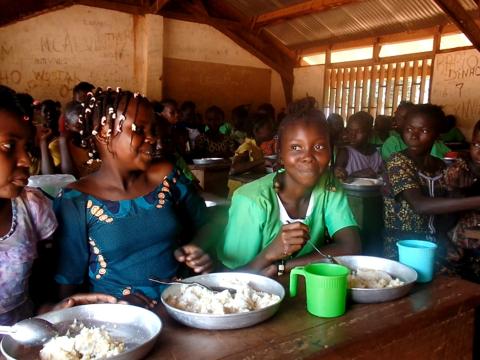Emergency school feeding provides motivation for pupils in CAR

When we listened to two girls paraphrasing the lyrics of one of their nursery rhymes by saying "Noon has come, WE ARE ABOUT TO EAT...”, instead of “Noon has come, I AM GOING BACK HOME...", we understood how much the World Food Programme's (WFP) emergency school feeding programme is motivating pupils to attend school. Moreover, for good reason, as they are guaranteed a "hot" meal at noon.
During the difficult times that the Central African Republic (CAR) went through due to clashes between the army and militias, one in two children did not go to school because of the violence.

Since 2014, World Vision has been working with WFP in CAR to save the lives of the suffering population. As part of their partnership agreement, World Vision and WFP have implemented an integrated food assistance project in more than six prefectures of CAR (Bouar, Bozoum, Batangafo, Paoua and Bambari, while a unit operates from the Bangui intervention office). The emergency school feeding programme is part of the activities of this integrated project.
Global data indicates that at least 388 million pre-school, primary and secondary students receive school feeding in 161 countries, based on a sample of 163 countries (WFP, 2020).
In Bambari, Jocelyne's school receives food from WFP as part of the emergency school feeding Programme.

A nutritious meal for every beneficiary
In its new school feeding strategy, published in January 2020, WFP has committed to ensuring that all primary school children have access to nutritious meals at school. In addition, NUTRIENT means CALORIC, but sufficient and light, and above all that it goes to the direct beneficiary, the student.
This is what Marlene, Monitoring Assistant in charge of school feeding at WFP in Bambari, explains: "During the advent of COVID-19, it was decided that each pupil should take his or her ration home (the Take Home Ration). However, more often than not, the ration for a single beneficiary, i.e. the child who goes to school, was shared with indirect beneficiaries who are the brothers and sisters of the real beneficiary. WFP considered - following a plea from the school inspectorate - that it is good that the meal is consumed on the spot to measure the impact of this activity”.

Nevertheless, it should be mentioned that the main objectives of the emergency school feeding interventions are to increase the school enrolment rate, especially for girls, to improve the school retention rate, to increase attendance, especially for girls, and to increase achievement.
Managers of schools where WFP provides hot meals confirm that primary schools have seen an increase in the retention rate of pupils and a decrease in the dropout rate of girls.
Ms. Matchipata, Director of Ecole Saint Christophe Filles, says: "The number of our pupils, which had dropped last year, has increased and we have almost doubled our enrolment, with a large number of girls attending. The WFP and World Vision programme to serve hot meals to the children has also contributed to this”.
This is immediately apparent when you walk into Jocelyne's classroom, sitting behind her plate with her friends, savouring her beans and rice meal: "I love this dish and I eat it with appetite every time it is presented to me at the table. At home, I like to prepare it with my older sisters”.
"Parents are grateful to WFP for the emergency school feeding programme, which eases their burdens and relieves the children", says Dieudonné, Jocelyne's father: "The meal that is served to the children at school helps us a lot, especially when the children come home and sometimes have to wait until we come back from the fields, at the evening, to get food”.
School meals account for 10% of the income of poor and vulnerable households, which is a significant saving for families with more than one child, according to WFP's School Feeding Situation Report 2020.

In 2021, a total of 16,400 children at school received WFP hot meals in 17 primary schools in Bambari Centre. At Ecole Application Saint Christophe, 2,080 pupils, including 1,041 girls, benefited from the intervention.